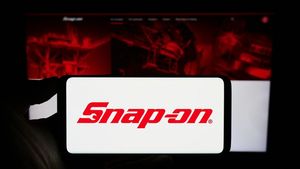
UiPath (NYSE: PATH), a leader in Robotic Process Automation (RPA), recently experienced a notable dip in its stock price around September 27, 2025, even as the company reported a strong fiscal Q2 2026 earnings turnaround. This divergence highlights a complex interplay between robust individual company performance and a cautious broader market sentiment that is currently sweeping across the technology sector. The event raises questions about investor priorities in a fluctuating economic landscape and the resilience of growth-oriented tech firms against macroeconomic pressures.
UiPath's Mixed Signals: Strong Earnings vs. Market Retreat
UiPath's stock performance leading up to late September 2025 presented a paradox. Following its fiscal Q2 2026 earnings report in early September, the company demonstrated impressive operational strength, shifting from an $86.10 million net loss in Q2 2025 to a $1.58 million net profit in Q2 2026. Revenue climbed by 14.4% to $361.73 million, and Annual Recurring Revenue (ARR) saw an 11% increase to $1.723 billion, surpassing guidance across critical financial metrics. These positive results initially propelled the stock upwards, with gains of over 10% on September 22, 2025, and an 8.3% surge in the seven days preceding September 24.
However, this positive momentum was short-lived. By September 27, 2025, UiPath's stock had declined by 7.08% over the preceding week, pushing its year-to-date performance to -8.20%. Several factors contributed to this reversal. Analyst sentiment, while cautiously optimistic overall with a consensus "Hold" rating, saw some firms like Truist Securities and TD Cowen lower their price targets to $12-$13, citing reduced free cash flow estimates and sector volatility. This cautious outlook, despite strong earnings, tempered investor enthusiasm. Adding to the mixed signals, UiPath CEO Daniel Dines executed a pre-arranged sale of 122,733 shares for approximately $1.46 million on September 18, 2025, an action that, regardless of its planned nature, can sometimes be perceived negatively by the market.
The most significant driver for the dip, however, appears to be the broader market conditions. The U.S. stock market, after reaching record highs earlier in September, experienced a widespread retreat in the days leading up to September 27. Major indices like the S&P 500, Nasdaq Composite, and Dow Jones Industrial Average all fell for several consecutive days due to investor apprehension over upcoming inflation data and scaled-back expectations for interest rate cuts. The Information Technology sector was a significant contributor to this downturn, indicating a potential shift in investor focus from broad tech exposure to more selective investments based on fundamental strength. This market-wide caution overshadowed UiPath's otherwise strong quarterly performance, pulling its stock down along with the wider tech segment.
Impact on the Automation Landscape: Winners and Losers
The recent volatility in UiPath's (NYSE: PATH) stock, alongside broader tech sector caution, creates a ripple effect across the intelligent automation landscape, distinguishing potential winners from those facing increased scrutiny. Pure-play Robotic Process Automation (RPA) vendors are particularly sensitive to these shifts, while diversified tech giants with integrated automation offerings appear better positioned.
Among direct competitors, Automation Anywhere (a private company) faces indirect pressure. As a major pure-play RPA vendor, its valuation and future IPO prospects are highly susceptible to investor sentiment surrounding public RPA companies. A cautious market view on RPA could depress its private market valuation, making it harder to raise capital or achieve a strong IPO. Conversely, if UiPath's challenges are seen as company-specific rather than an industry-wide issue, Automation Anywhere, with its cloud-native and AI-powered platform, might attract customers seeking perceived stability or alternative solutions.
Diversified technology companies with integrated automation capabilities stand to gain significantly. Microsoft (NASDAQ: MSFT), with its Power Automate deeply embedded in the Microsoft 365 and Azure ecosystems, is a formidable beneficiary. As customers grow wary of standalone RPA tools, they may gravitate towards Power Automate for its seamless integration, low-code approach, and extensive AI capabilities via AI Builder and Copilot. Similarly, SAP (NYSE: SAP), through SAP Build Process Automation, leverages its deep integration with core SAP solutions (ERP, CRM) to attract enterprises already invested in its ecosystem, offering a unified automation experience. IBM (NYSE: IBM), with its IBM RPA integrated into Cloud Pak for Business Automation, also benefits from its extensive enterprise software and AI capabilities, appealing to customers seeking robust, scalable solutions from a global technology leader.
Other players like SS&C Technologies (NASDAQ: SSNC), which acquired Blue Prism (now SS&C Blue Prism), are less directly impacted by UiPath's stock performance due to their diversified portfolios. However, a general downturn in RPA sentiment could affect the perceived value and growth of SS&C's automation segment. Pegasystems (NASDAQ: PEGA) and Appian (NASDAQ: APPN), both offering low-code platforms combining RPA with Business Process Management (BPM) and broader application development, could win by attracting enterprises looking for integrated, end-to-end automation solutions rather than siloed RPA tools. These companies are well-positioned if the market prioritizes comprehensive process management over discrete task automation. NICE (NASDAQ: NICE), focused on customer experience software with integrated RPA, could also benefit as businesses seek embedded automation within broader platforms. Finally, Alteryx Inc. (NYSE: AYX), specializing in data analytics and process automation, might gain if the market shifts towards data-driven intelligent automation, appealing to companies automating complex, data-centric processes.
Broader Implications: RPA's Evolving Role in a Volatile Market
The recent dynamics surrounding UiPath's (NYSE: PATH) stock performance, characterized by strong financial results countering earlier market apprehension, offer a powerful lens through which to view the broader evolution of the Robotic Process Automation (RPA) industry and the wider tech sector in late 2025. This event underscores several critical shifts, from the pervasive integration of AI to the increasing demand for comprehensive, value-driven automation solutions.
At the heart of this transformation is the rapid convergence of RPA with Artificial Intelligence (AI) and Machine Learning (ML), leading to what is now widely termed "Intelligent Automation" or "Hyperautomation." This trend moves beyond simple task automation, enabling RPA bots to process unstructured data, make complex decisions, and orchestrate end-to-end workflows. The global intelligent process automation market is projected for substantial growth, reflecting an industry-wide push to leverage AI, including Generative AI (GenAI), for enhanced efficiency, accuracy, and scalability. UiPath itself is actively positioning with "agentic automation," signaling its commitment to this AI-first future.
The ripple effects of these trends extend to competitors and partners alike. While UiPath's strong performance generally reinforces its market leadership, it also intensifies pressure on rivals like Automation Anywhere and SS&C Blue Prism (part of SS&C Technologies (NASDAQ: SSNC)) to rapidly innovate their AI-driven offerings. Tech giants such as Microsoft (NASDAQ: MSFT) and SAP (NYSE: SAP), with their deeply integrated automation platforms, are well-positioned to capitalize on the market's demand for holistic solutions. System integrators and consulting firms, crucial partners in RPA implementation, are seeing increased opportunities but must now evolve to deliver complex, AI-infused automation strategies.
Regulatory and policy implications are also coming to the forefront. As automation permeates more business functions, concerns around data privacy and security (e.g., GDPR, CCPA compliance) are paramount, driving a focus on "shift-left" RPA and zero-trust architectures. The ethical dimensions of AI, including algorithmic bias and transparency, are drawing increased scrutiny, with expectations for companies to adopt robust ethical AI frameworks. Furthermore, the impact of automation on the workforce necessitates policy discussions around reskilling and upskilling initiatives to prepare for an AI-powered economy, mitigating potential job displacement concerns.
Historically, the enterprise software market offers valuable precedents. The resilience of Software-as-a-Service (SaaS) models during the 2008–2009 financial crisis, being operational expenses rather than capital outlays, is mirrored in the current shift towards cloud-native and consumption-based RPA. This model offers greater flexibility during economic fluctuations. Moreover, much like cloud adoption accelerated during past downturns, generative AI is emerging as a potential accelerator in the mid-2020s. Economic pressures might compel enterprises to adopt AI-powered automation to preserve capacity and optimize headcount, thereby accelerating digital transformation. However, a broader trend indicates a move away from expensive, generic enterprise software towards custom AI solutions, demanding higher ROI and adaptability from all vendors, including RPA providers.
The Road Ahead for UiPath and the RPA Industry
The trajectory of UiPath (NYSE: PATH) and the broader Robotic Process Automation (RPA) industry is set against a backdrop of rapid technological evolution, particularly the pervasive integration of Artificial Intelligence (AI) and Generative AI (GenAI). As of late September 2025, the market signals for UiPath are a blend of strong operational performance and strategic adaptation to capitalize on emerging opportunities while navigating inherent challenges.
In the short-term (next 12-18 months), UiPath is expected to intensify its focus on embedding GenAI across its platform. This includes the general availability of specialized Large Language Models (LLMs) like DocPath and CommPath for enhanced document processing and communication. A key strategic pivot will be the continued development and rollout of "agentic capabilities," allowing AI agents to autonomously understand, plan, and execute complex workflows, moving beyond simple rule-based automation. Strategic partnerships, such as those with Inflection AI for secure private cloud/on-premises AI solutions and global expansion initiatives with partners like HCLTech, will be crucial for broadening market reach. UiPath will also continue to emphasize its cloud-native offerings and low-code/no-code capabilities to democratize automation and drive customer adoption from pilots to full production deployments. Its strong, debt-free balance sheet provides the financial flexibility for continued innovation and potential strategic acquisitions.
However, short-term challenges include intense competitive pressure from a crowded hyperautomation market, the need to ensure customers and their workforces can effectively adapt to and manage increasingly complex AI-powered solutions, and the lingering impact of broader economic uncertainties on enterprise IT spending.
Looking long-term (next 3-5+ years), the RPA industry will see continuous evolution, with RPA becoming an integral, rather than standalone, component of comprehensive hyperautomation suites. These suites will extensively leverage AI, Machine Learning, and process mining to create highly intelligent and autonomous processes. By 2030, interactions with smart robots are projected to be ubiquitous, with automation capable of handling highly cognitive tasks, continuously learning, and adapting. The focus will shift from merely automating tasks to achieving sustained strategic outcomes, aligning automation efforts with core business objectives to enhance efficiency, customer satisfaction, and long-term value creation. This will also necessitate robust AI governance frameworks to ensure ethical, unbiased, and accountable decision-making, alongside initiatives to address workforce transformation through upskilling and reskilling.
For UiPath specifically, potential long-term scenarios include maintaining leadership through aggressive investment in AI, GenAI, and agentic automation, potentially expanding its platform through diversification or strategic acquisitions in related areas like process mining or intelligent document processing. Given its strong technology and market position, UiPath could also become an attractive acquisition target for larger enterprise software companies seeking to bolster their AI and automation portfolios. Conversely, a failure to rapidly adapt to the latest AI advancements or to effectively manage large-scale hyperautomation deployments could lead to a loss of market share to more agile competitors or broader platform plays. The ultimate outcome will depend on UiPath's ability to consistently innovate, execute its strategy, and effectively communicate the tangible value of its evolving automation platform in a rapidly changing technological and economic environment.
Concluding Thoughts: Navigating Uncertainty in the Automation Era
UiPath (NYSE: PATH) stands at a pivotal juncture, having navigated earlier stock dips to demonstrate a strong fiscal Q2 2026 performance amidst a rapidly evolving enterprise automation landscape. The key takeaway is the undeniable shift from basic Robotic Process Automation to sophisticated, AI-driven hyperautomation, where the integration of Machine Learning, Generative AI, and process mining is creating truly intelligent and autonomous systems. This evolution is not merely incremental; it represents a fundamental redefinition of how businesses achieve efficiency, reduce costs, and enhance strategic agility.
Moving forward, the market will continue its robust expansion, driven by the imperative for digital transformation across all industries. Intelligent automation, with its capacity to learn, adapt, and make autonomous decisions, will increasingly reduce human interaction in routine tasks, freeing up the workforce for more strategic and creative endeavors. The dominance of cloud-native, low-code/no-code platforms, coupled with advanced process mining capabilities, will democratize automation, making it accessible to a wider range of business users and ensuring that automation efforts are precisely targeted for maximum impact.
The lasting impact of these trends will be profound. Companies that strategically embrace integrated, AI-powered automation will not only streamline operations but also gain a significant competitive advantage, enabling them to innovate faster and respond more effectively to market dynamics. This era demands a holistic approach to automation, one that considers ethical AI, robust governance, and continuous workforce adaptation.
For investors, the coming months will require close observation of several key indicators. Watch for UiPath's continued innovation in AI and agentic automation, particularly the adoption rates of new features like Autopilot and Agent Builder, as these are critical for maintaining its competitive edge. Sustained growth in Annual Recurring Revenue (ARR) and Net Retention Rate (NRR) will signal strong customer value and market penetration. Consistent improvements in profitability and operational efficiency, especially non-GAAP operating income, will be crucial for demonstrating sustainable growth. Furthermore, keep a keen eye on the competitive landscape, including strategic partnerships and acquisitions, as the market continues to consolidate and evolve. Finally, while company-specific performance is vital, investors should remain cognizant of broader macroeconomic conditions, as these can still influence overall IT spending and market sentiment.
This content is intended for informational purposes only and is not financial advice





